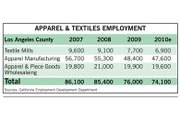Local Economists See Slightly Sunnier View Ahead of Us
For once, people are saying something positive about the economy.
“The outlook is the most optimistic we’ve had in years,” said Dr. Nancy Sidhu, the Los Angeles County Economic Development Corp.’s chief economist, who presented the organization’s “2011–2012 Economic Forecast and Industry Outlook” on Feb. 16 at the Los Angeles Marriott Downtown. “The economy is growing again almost everywhere,” she said, pointing to gains in some key industries, including automotive sales, international trade, entertainment, tourism and healthcare.
Dr. David Berson, Fannie Mae’s former chief economist and the senior vice president and chief economist at the PMI Group Inc., a Walnut Creek, Calif.–based private-mortgage insurer, said the national economy has grown for 20 straight months. “The growth has been steady and looks like it is accelerating. We should see stronger growth in 2011 and 2012.”
Still, while the LAEDC expects measurable economic recovery across the state in the coming years, growth will be moderate. “The state’s labor markets will improve only slowly in 2011, with nonfarm employment growing by 0.8 percent or by 111,800 jobs,” the forecast said. “Economic conditions will improve more noticeably in 2012.”
Los Angeles County will experience gradual economic growth during 2011 and 2012. The garment industry
The apparel design and manufacturing sector, one of Southern California’s key economic drivers, did poorly on the LAEDC’s “Performance Ratings of Major Industries” analysis, earning a grade of C-.
This is due to projected retail closures and consumers who are buying more but focusing on value.
For the local apparel industry, there are several challenges for primarily small- to medium-sized firms. “First, there is the issue of undocumented workers. Immigrants occupy a large number of production positions in the industry,” the forecast said. “However, the immigration service has adopted a much harder stance regarding undocumented workers, which has impacted the workforce of some larger apparel manufacturers in the region.”
U.S. customs officials are scrutinizing the classification of imported textiles, which can add costs and delays to shipments.
Employment in the apparel manufacturing and wholesale business is expected to decline in 2011 and 2012 as more production is outsourced overseas but not at the rate experienced in 2008 and 2009. Design work is expected to see an uptick.
However, apparel retail is a bright spot. Attendance at apparel trade shows and buying markets in Los Angeles is growing. Retail sales at stores and malls have increased. On the other hand, the spike in cotton prices may place a hurdle in front of shoppers.
While apparel wasn’t a major economic driver for the local economy, other industries that showed strong potential were tourism and travel, technology, motion picture and television production, and international trade.Japan as economic partner
The LAEDC also presented a report called “Growing Together: Japan & Los Angeles,” which highlighted the “mutually beneficial” relationship the two economies have built over the last 120 years.
Japan is the No. 1 source of foreign investment in Los Angeles County and the second-biggest trading partner in the Los Angeles Customs District. Total two-way trade was valued at $48.3 billion. Japanese imports through Los Angeles ports were $35.6 billion, while total exports to Japan totaled $12.7 billion.
However, apparel does not figure prominently in the trade between Los Angeles County and Japan. The report, however, did highlight some Southern California companies—such as American Apparel, Forever 21, 7 For All Mankind and BCBGMaxAzria—that maintain stores in Japan or distribute their apparel there.
The top 10 exports from the Port of Los Angeles to Japan are plastics and plastic products, organic chemicals, computer parts and machinery, inorganic chemicals, meat and meat products, vehicle and auto parts, chemical products, optical and medical instruments, electrical equipment and components, and grains, seeds, fruits and plants, in that order.






















